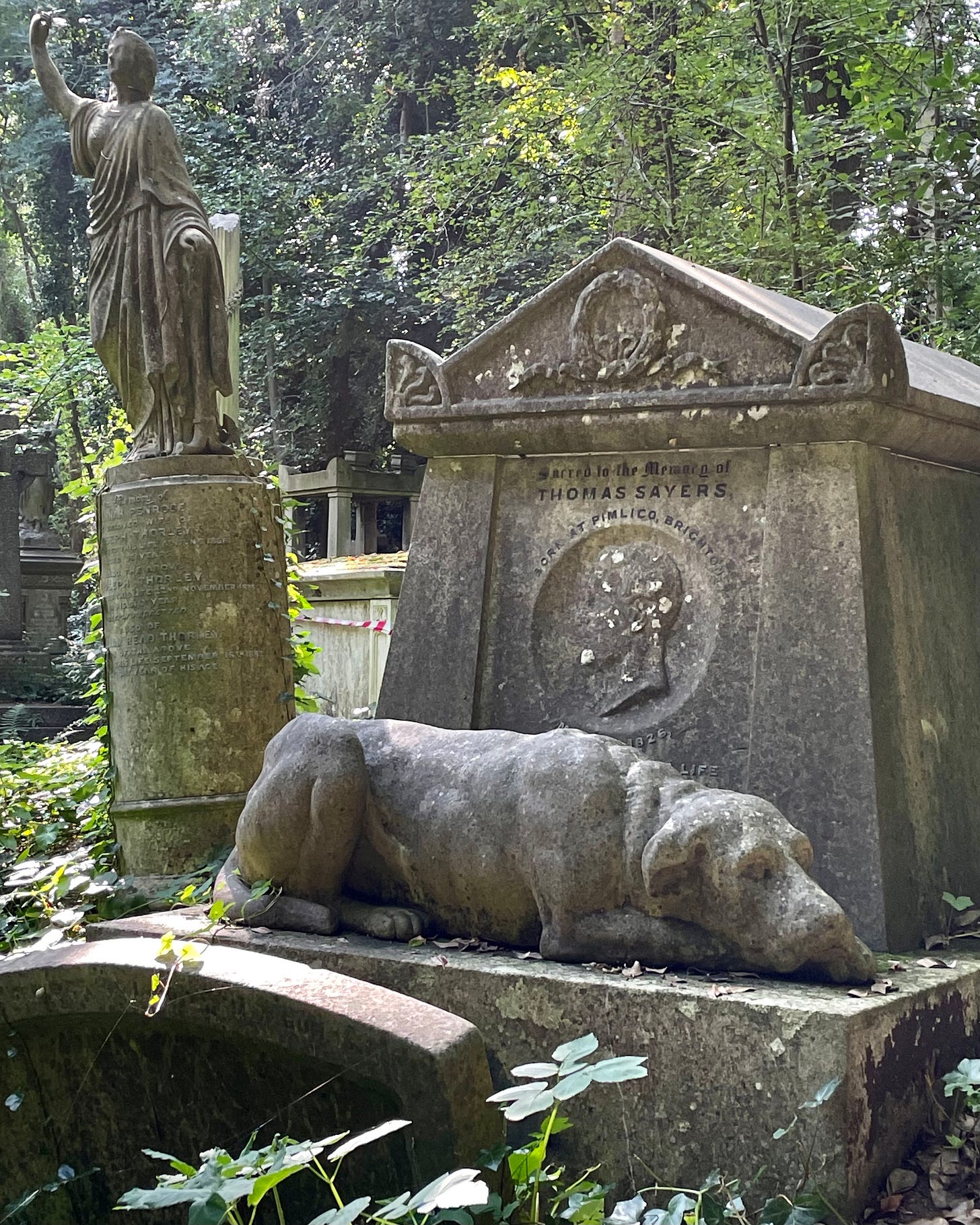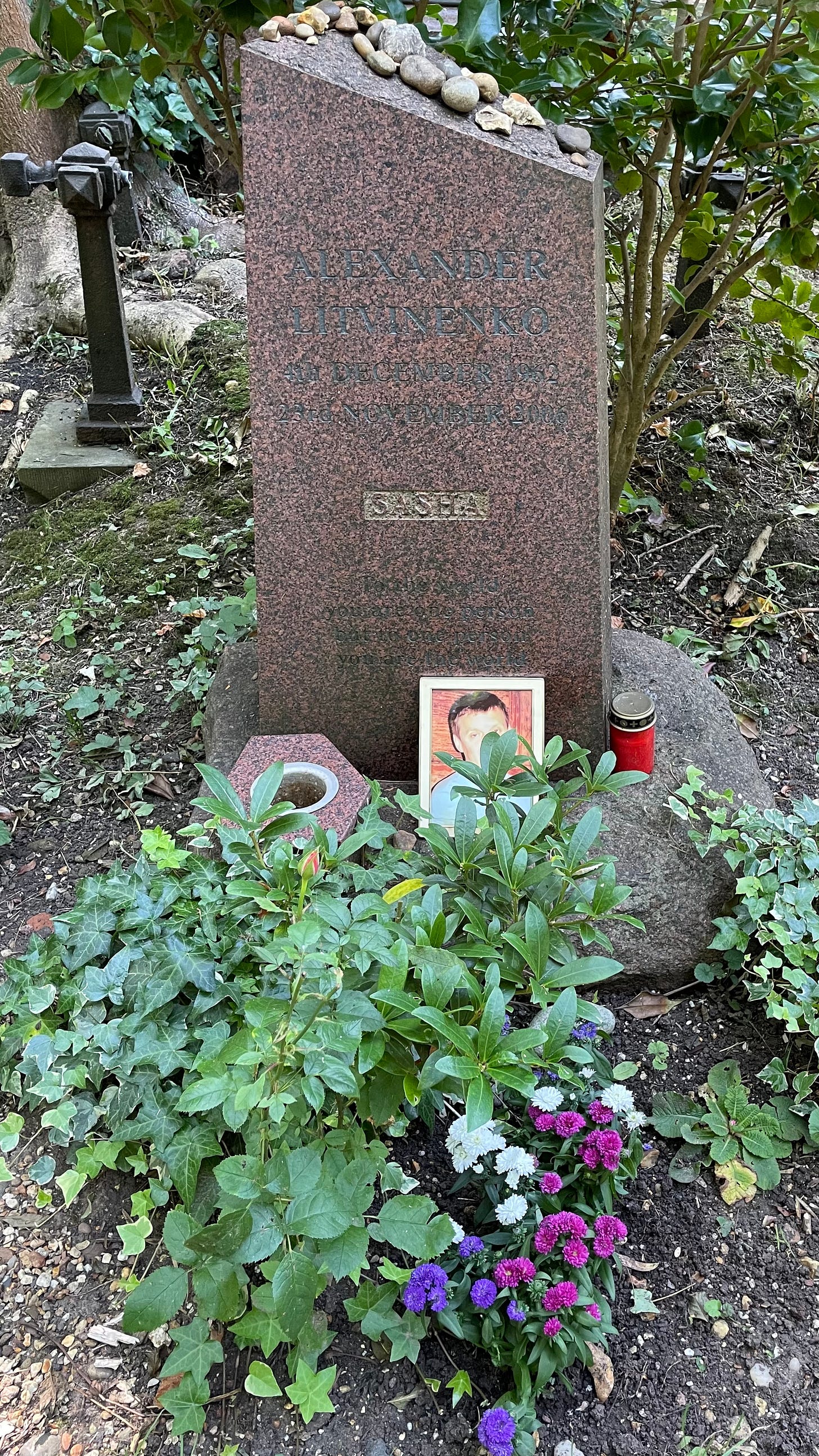Ghoulish Graveyards and COP26
Burials are not environmentally friendly, but London’s Highgate Cemetery is still the poshest place to spend the afterlife
The grave of one Thomas Sayers (1826-1865) an bare-knuckled prize fighter whose funeral was the largest to date at London’s Highgate Cemetery. The dog, “Lion” was his constant companion, but is buried elsewhere.
Dear friends and fellow countrymen,
A few years back, I wrote about a place called the DeathLab at Columbia University — a center with one specific problem to solve: make death environmemtally sustainable. The story, for Atlas Obscura, focused on the problem in New York, specifically, and went something like this: “For the past five years, DeathLab has been focused—during an era of global warming, overcrowding and leave-no-trace environmentalism—on solving the problem of last rites in New York, where an average of 144 bodies stack up per day.
“That, in turn, totals around half a million plots per decade, consuming nearly all of the ground left in the dozens of cemeteries and polluting the air with cremation smog in the New York metropolitan area.”
Seems as if London is having a similar problem.
The headstone of Malcolm Mclaren (1946-2010), described as an “impresario, rock-artist, clothes designer and boutique owner,” by the Highgate guide. No mention of the boutique he ran with Vivienne Westwood, called Sex, nor his management of the Sex Pistols or the New York Dolls.
Each year, 140,000 people in the UK still choose to be buried. In 2013, a BBC study found that a quarter of local authorizes, which are responsible for the overwhelming majority of cemeteries, expected most to be out of room by 2023. Two London boroughs, Hackney and Tower Hamlets, have already stopped providing burials in their boroughs. And as the housing crisis has put home ownership out of the reach of growing numbers of people, so too burial plots risk becoming unaffordable.
The gravesite of pianist Harry Thornton (1883-1918), who died in London’s flu pandemic.
On top of cutting down trees in favor of headstones, it is toxic to the environment to bury people, thanks to all the chemicals pumped into bodies to preserve them. And if cremation seems like a more sensible choice, think again. Cremation just drives smoke and more CO2 into the sky, according to DeathLab. Therefore, even the simplest graves in North London's Highgate Cemetery are a bit of an extravagance — not to mention the headstones reflecting certain people's professions, including horse trainers, professional pianists and the Sex Pistols manager Malcolm McLaren.
John Atcheler (1792-1867) became rich and famous as a “knacker”, describing himself as “horse slaughterer to Queen Victoria.”
Interesting enough, Highgate was originally built in the 1800s to stem the overcrowding in churchyards, which was described as “indecent and unsanitary” causing outbreaks of cholera and typhoid. Highgate, run by the London Cemetery Company, opened in 1839 and became not only a place to mourn, but also a tourist attraction, with the dead outdoing each other in size and grandeur of gravestone. Soon, however, Highgate filled up too, and expanded from West to another 17 acres in the East. After a period of neglect and decay, the Friends of Highgate Cemetery Trust rescued the disintegrating burial ground.
But instead of developing a more eco-friendly burial process, such as the one at Bristol's Amos Vale cemetery, in which bodies are disintegrated into liquid nitrogen and then glow until they burn out, Highgate continues to build crypts and graves, including moving Karl Marx's grave from his original spot, constructing a massive garden for the son of a Russian oligarch and making sure the novelist Julian Barnes' wife has a nice plot. Still, tourist continue flock to the famous cemetery every year and it is still selling plots. Here are a few of its most famous…
Jim Horn (1976-2010) might have been an avid reader of Penguin book, but he was not a partner in the firm. The penguin symbol is representative of penguins mating for life and the word Partner” awaits an “s” presumably for Horn’s life partner.
Karl Marx (1818-1883), the German “political philosopher and revolutionary socialist” is probably Highgate’s most famous resident. Marx, a stateless person, died of bronchitis and pleurisy, in London, where he had lived for many years.
Mansoor Hekmat (1951-2002) was a Iranian follower of Marx and leader of the worker-communist movement.
The grave of pop artist Patrick Caulfield (1936-2015) who, along with Peter Blake and David Hockney, fostered the movement in England. His work hangs at the Tate.
The grave of former Russian intelligence agent and dissident, Alexander Litvinenko (1962-2010), who died in London’s University College Hospital after being poisoned with the radioactive Polonium-210.
The apropos grave of Richard “Stoney” Smith (1836-1900), the Milner who founded the popular flour (and bread company) Hovis.
Ever yours,
Adrian
English or American Rebuttal
If you or a friend want to debate any thought in this newsletter, please leave a comment!
Housekeeping:
If you enjoy this newsletter — and the photographs — I ask that you subscribe. Your small donation goes a long way toward my goal of what the English call “permanent leave to remain” and the Americans call “to stay in the country.”













